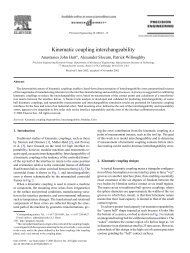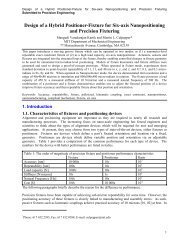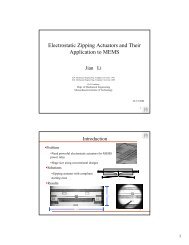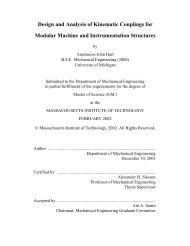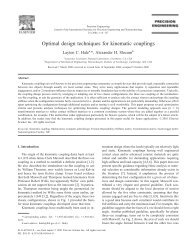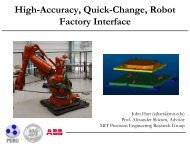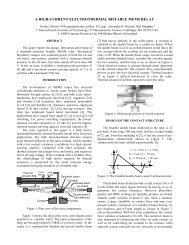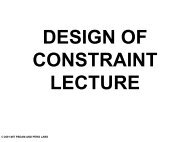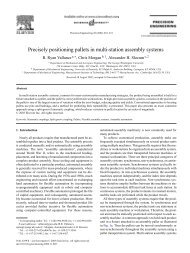Friction-Based Design of Kinematic Couplings
Friction-Based Design of Kinematic Couplings
Friction-Based Design of Kinematic Couplings
- No tags were found...
Create successful ePaper yourself
Turn your PDF publications into a flip-book with our unique Google optimized e-Paper software.
The local contact areas typical <strong>of</strong> these kinematiccouplings are quite small and require a Hertzian analysisto ensure a robust design. Greater durability is achievedby curvature matching such as a ball against a concavesurface and/or by using ceramic materials such as siliconnitride balls against tungsten carbide gothic arches.<strong>Design</strong>s based on line contact rather than point contact<strong>of</strong>fer a significant increase in load capability. Forexample, a kinematic equivalent to three vees is a set <strong>of</strong>three balls in three conical sockets with either the ballsor the sockets supported on radial-motion flexures.Alternatively, the three-tooth coupling shown in Figure2 is based on three theoretical lines <strong>of</strong> contact formedbetween cylindrical and flat teeth. Each line constrainstwo degrees <strong>of</strong> freedom giving a total <strong>of</strong> six constraints.Manufactured with three identical cuts directly into eachcoupling half, the teeth must be straight along the lines<strong>of</strong> contact but other tolerances can be relatively loose.<strong>Friction</strong> Effects<strong>Friction</strong> affects at least four important characteristics <strong>of</strong>a kinematic coupling as indicated by order-<strong>of</strong>-magnitudeestimates that all include the coefficient <strong>of</strong> friction µ.1) Repeatabilityfk2) <strong>Kinematic</strong> support ft≤µ fn3) StiffnessP≈ µ ⎛ 2 13 23⎞ ⎛ ⎞⎝ 3R⎠⎝ E⎠132−2ν⎛ fkt= kt ⎞n ⎜1− ⎟2 − ν ⎝ µ fn⎠≈ 083 . knf4) Centering ability c ≈ 05 . −13. µfnTangential friction forces at the contacting surfacesmay vary in direction and magnitude depending how thecoupling comes into engagement. This affects therepeatability <strong>of</strong> the coupling and the kinematic support<strong>of</strong> the precision component. The estimate forrepeatability is the unreleased frictional force multipliedby the coupling’s compliance. The estimate is derived asif the coupling’s compliance in all directions is equal toa single Hertzian contact carrying a load P and having arelative radius R and elastic modulus E. The frictionalforce acts to hold the coupling <strong>of</strong>f center in proportionto the compliance. This estimate will underestimate therepeatability if the structure <strong>of</strong> the coupling is relativelycompliant compared to the contacting surfaces.<strong>Kinematic</strong> support is important for stability <strong>of</strong>shape <strong>of</strong> the precision component. The estimate forkinematic support simply gives a bound on themagnitude <strong>of</strong> friction force acting at any contact surface.A sensitivity analysis <strong>of</strong> the precision component willdetermine a tolerable level <strong>of</strong> friction that the couplingcan have. This may drive the design to include flexureelements and/or procedures to release stored energy. Ifrepeatable engagement is not so important, thenconstraints using rolling-element bearings <strong>of</strong>fer very lowfriction. For example, a pair <strong>of</strong> cam followers thatcontact with crossed axes is equivalent to a ball on a flatbut with twenty or so times less friction.In some cases frictional overconstraint is valuablefor increasing the overall system stiffness. Provided thetangential force is well below what would initiatesliding, the tangential stiffness <strong>of</strong> a Hertz contact iscomparable to the normal stiffness [Johnson, 1985].This was important for the National Ignition Facilitywhere frictional overconstraint stiffened the firsttorsional mode <strong>of</strong> optics assemblies sufficiently to meetdynamic stability requirements.Centering ability can be expressed as the ratio <strong>of</strong>centering force to nesting force and the estimate shownis typical. A larger ratio means the coupling is better atcentering in the presents <strong>of</strong> friction. Later, it isconvenient to express centering ability as the coefficient<strong>of</strong> friction where the ratio goes to zero. For the estimate,the limiting coefficient <strong>of</strong> friction is 0.5/1.3 = 0.38. Thecoupling will center if the real coefficient <strong>of</strong> friction isless than the limiting value.Centering AbilityThe contacting surfaces <strong>of</strong> a kinematic coupling comeinto engagement sequentially unless it is placedprecisely at the exact center. The path to center isconstrained by the surfaces already in contact. Forexample, five surfaces in contact constrain the couplingto slide along a well-defined path. Four surfaces incontact allow motion over a two-dimensional surface <strong>of</strong>paths and so forth. Although there are infinitely manypaths to center, only the limiting case is <strong>of</strong> practicalinterest for determining centering ability. Further, it isreasonable to expect the limiting case to be one <strong>of</strong> sixpossible paths that have five surfaces in contact. 3 Thispoint is demonstrated using the three-vee coupling.For any given path to center, the centering forcethat results from the nesting force may be derived usingStatics and the Coulomb law <strong>of</strong> friction. Figure 3 shows3 The exception to this statement is the ball-coneconstraint <strong>of</strong> the cone-vee-flat coupling since the coneprovides only one constraint until the ball is fullyseated. A tetrahedral socket remedies this situation.2




